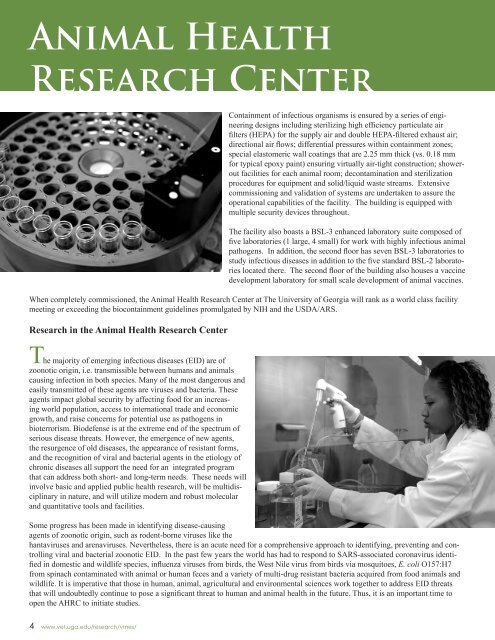The Animal Health Research Center - University of Georgia College ...
The Animal Health Research Center - University of Georgia College ...
The Animal Health Research Center - University of Georgia College ...
You also want an ePaper? Increase the reach of your titles
YUMPU automatically turns print PDFs into web optimized ePapers that Google loves.
<strong>Animal</strong> <strong>Health</strong><br />
<strong>Research</strong> <strong>Center</strong><br />
Containment <strong>of</strong> infectious organisms is ensured by a series <strong>of</strong> engineering<br />
designs including sterilizing high efficiency particulate air<br />
filters (HEPA) for the supply air and double HEPA-filtered exhaust air;<br />
directional air flows; differential pressures within containment zones;<br />
special elastomeric wall coatings that are 2.25 mm thick (vs. 0.18 mm<br />
for typical epoxy paint) ensuring virtually air-tight construction; showerout<br />
facilities for each animal room; decontamination and sterilization<br />
procedures for equipment and solid/liquid waste streams. Extensive<br />
commissioning and validation <strong>of</strong> systems are undertaken to assure the<br />
operational capabilities <strong>of</strong> the facility. <strong>The</strong> building is equipped with<br />
multiple security devices throughout.<br />
<strong>The</strong> facility also boasts a BSL-3 enhanced laboratory suite composed <strong>of</strong><br />
five laboratories (1 large, 4 small) for work with highly infectious animal<br />
pathogens. In addition, the second floor has seven BSL-3 laboratories to<br />
study infectious diseases in addition to the five standard BSL-2 laboratories<br />
located there. <strong>The</strong> second floor <strong>of</strong> the building also houses a vaccine<br />
development laboratory for small scale development <strong>of</strong> animal vaccines.<br />
When completely commissioned, the <strong>Animal</strong> <strong>Health</strong> <strong>Research</strong> <strong>Center</strong> at <strong>The</strong> <strong>University</strong> <strong>of</strong> <strong>Georgia</strong> will rank as a world class facility<br />
meeting or exceeding the biocontainment guidelines promulgated by NIH and the USDA/ARS.<br />
<strong>Research</strong> in the <strong>Animal</strong> <strong>Health</strong> <strong>Research</strong> <strong>Center</strong><br />
<strong>The</strong> majority <strong>of</strong> emerging infectious diseases (EID) are <strong>of</strong><br />
zoonotic origin, i.e. transmissible between humans and animals<br />
causing infection in both species. Many <strong>of</strong> the most dangerous and<br />
easily transmitted <strong>of</strong> these agents are viruses and bacteria. <strong>The</strong>se<br />
agents impact global security by affecting food for an increasing<br />
world population, access to international trade and economic<br />
growth, and raise concerns for potential use as pathogens in<br />
bioterrorism. Biodefense is at the extreme end <strong>of</strong> the spectrum <strong>of</strong><br />
serious disease threats. However, the emergence <strong>of</strong> new agents,<br />
the resurgence <strong>of</strong> old diseases, the appearance <strong>of</strong> resistant forms,<br />
and the recognition <strong>of</strong> viral and bacterial agents in the etiology <strong>of</strong><br />
chronic diseases all support the need for an integrated program<br />
that can address both short- and long-term needs. <strong>The</strong>se needs will<br />
involve basic and applied public health research, will be multidisciplinary<br />
in nature, and will utilize modern and robust molecular<br />
and quantitative tools and facilities.<br />
Some progress has been made in identifying disease-causing<br />
agents <strong>of</strong> zoonotic origin, such as rodent-borne viruses like the<br />
hantaviruses and arenaviruses. Nevertheless, there is an acute need for a comprehensive approach to identifying, preventing and controlling<br />
viral and bacterial zoonotic EID. In the past few years the world has had to respond to SARS-associated coronavirus identified<br />
in domestic and wildlife species, influenza viruses from birds, the West Nile virus from birds via mosquitoes, E. coli O157:H7<br />
from spinach contaminated with animal or human feces and a variety <strong>of</strong> multi-drug resistant bacteria acquired from food animals and<br />
wildlife. It is imperative that those in human, animal, agricultural and environmental sciences work together to address EID threats<br />
that will undoubtedly continue to pose a significant threat to human and animal health in the future. Thus, it is an important time to<br />
open the AHRC to initiate studies.<br />
4 www.vet.uga.edu/research/vmes/

















